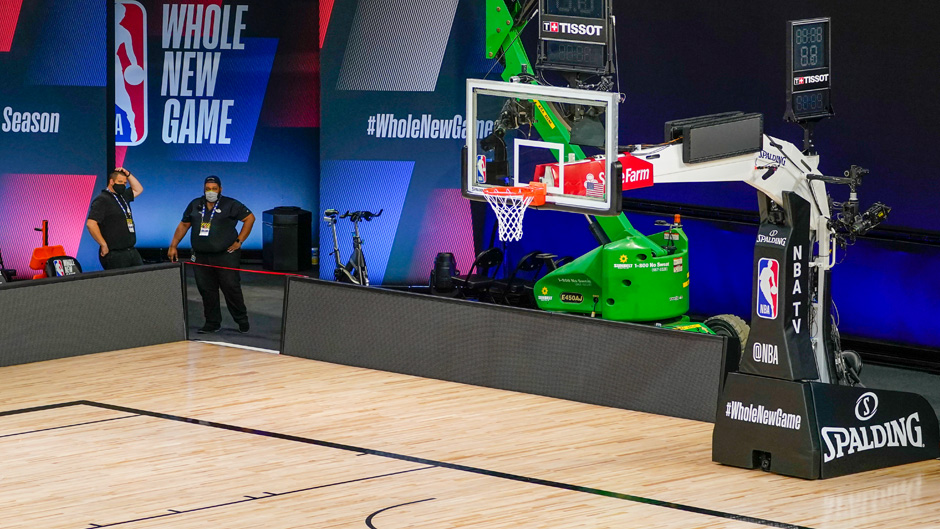Toting enough luggage to last for a three-month vacation, the first NBA players started arriving at Disney World in the early summer of 2020. But there would be no theme park rides, fireworks displays, or parades during this trip. Their stay at “The Most Magical Place on Earth” would be a total lockdown.
A total of 22 of the league’s 30 teams—322 players in all—would sequester in a ‘bubble’ in the Disney World complex, completing an abridged regular season after a four-month hiatus caused by COVID-19.
Missing would be the distinctive atmosphere of NBA games. No fans allowed. Only piped-in music and virtual crowd noise. In truth, that’s what it took to protect the players from a virus that was at its height during a year like no other.
“There was no blueprint for this. No one had already decided that this is how you bring back a league and create a bubble,” said Joseph Graziano, the NBA’s senior vice president for business operations and global events. “Our player health team, which would traditionally be worried about things like why there are too many ankle injuries happening across the league, had to transition to deal with a global pandemic.”
Graziano’s comments were part of the panel “COVID-19 and the NBA Bubble,” one of a series of discussions held last week as part of the University of Miami School of Law’s Global Entertainment and Sports Law and Industry Conference.
Presented by the Entertainment and Sports Law Society and the LL.M. in Entertainment, Arts and Sports Law, the two-day symposium addressed a range of issues, with talks focusing on everything from concussion litigation and mental health in sports to the growing popularity of eSports and the current state of the music industry in Latin America.
“Each year this conference has grown, and this year, we pulled together one of our most dynamic lineups to address business, legal, and social issues,” said Greg Levy, associate dean and director of the Entertainment, Arts, and Sports Law LL.M.
The panel on the NBA bubble, moderated by School of Law adjunct professor Adam Schlatner, was presented as industry personnel continue to study the unprecedented quarantine of more than 1,500 players, coaches, and staff, calling it an experiment unlike any in the history of sports.
“Basketball is least suited for a pandemic,” Graziano said during the one-hour virtual talk, noting that NBA players compete indoors and in close contact with each other, two factors that are ideal for the spread of the coronavirus. “We knew we were up against it.”
So, to prevent an outbreak, the league implemented stringent health and safety protocols inside the bubble, adopting Centers for Disease Control and Prevention recommendations of testing, mask wearing, social distancing, and contact tracing, Graziano explained.
Their protocols went even further, as Graziano and his team reinvented the buffet experience for players, installing plexiglass shields throughout dining facilities. Crews also installed upgraded HVAC and air-circulation systems in the venues where games were played.
And after each practice session and game, a team of custodians cleaned the courts extensively. “To make that happen, we set up a practice court facility, conducting time trials to see how quickly our custodians could complete the deep-cleaning process,” said Faron D. Kelley, vice president of ESPN Wide World of Sports, runDisney, and Disney’s Water Parks.
The result: Not a single player who cleared quarantine tested positive for the virus during the nearly 100 days of the bubble, which included playoff games.
Faron and Graziano had their initial conversation to plan the bubble on May 4, coming up with a list of almost 170 questions that needed to be addressed. “Would it be an abbreviated season? And what about COVID cleaning protocols, which were being written as we went along?” Faron recalled. “Back then, surface transmission was still a big issue.”
It took just 38 days from that initial phone call to get a contract signed to operate the bubble. “That was lightspeed,” Graziano said. “It was seven days a week, and midnight and 1 a.m. calls were not uncommon.”
Along the way, they dealt with endless challenges—such as ordering and having hundreds of oversized mattresses delivered to the three Disney hotels that housed players. They also needed a dedicated laundry facility. “We couldn’t have LeBron’s jersey being thrown in with the towels,” Faron said.
Then came the day when competition inside the bubble ceased temporarily, not because of a positive COVID-19 test but because of players boycotting playoff games to protest the police shooting of Jacob Blake in Kenosha, Wisconsin. It started with the Milwaukee Bucks refusing to take to the court for their Game 5 playoff matchup against the Orlando Magic on Aug. 26.
“Organizationally, we supported our players, and our players supported the stance that the Milwaukee Bucks took to not come out and play,” said the third panelist on the talk, Nyea Sturman, vice president and general counsel of the Orlando Magic.
Other NBA playoff games were postponed. And across the nation, the protests spawned a movement. WNBA, Major League Baseball, and Major League Soccer teams quickly followed suit, boycotting games in their respective leagues.
“Health and safety were the bedrock principles of the restart,” Graziano said. “But it had to be about more than just basketball. We had to return [resume play] for reasons beyond the game. And that meant using our platform to highlight systemic racism and social injustice in the country.”

